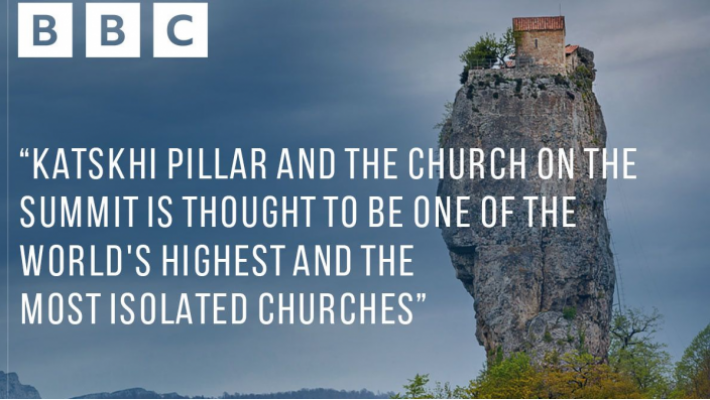Priyanka Shankar, a journalist from an influential British publication, traveled to Georgia and shared her impressions of Imereti with the readers.
"As I drove through the remote Imereti region of central-western Georgia, rolling hills and lush pine forests flanked the empty roads and grazing cows dotted the verdant landscape. It was a picture-perfect rural scene. Suddenly, the car rounded a bend and an incongruous sight appeared high above the canopy: up ahead, a massive limestone monolith jutted into the sky, about 40m tall, with a small church perched on the top.
I'd finally reached the Katskhi Pillar.
I had travelled 220km from Georgia's capital Tbilisi to visit this soaring stone structure. I'd long been fascinated by the famous Greek monasteries of Meteora – which are also precipitously built on natural rock pillars – and when I'd heard of an extraordinary church where daring monks climb to be closer to heaven, I knew I had to visit. Monks lived on top of the Katskhi Pillar for centuries; the last one only came down for good in 2015. Today, it's a pilgrimage site for many Orthodox Christians, as well as a tourist attraction for people who flock here to here to witness the nerve-jangling sight of monks dangling off the steep rock edge.
Dedicated to a monk named Maximus the Confessor, the church is one of the world's highest and most isolated churches. It is thought to have been built somewhere between the 6th and 8th Centuries by Stylites, or "pillar monks", who believed that praying on top of pillars or high cliffs would distance them from worldly temptations.
According to local legend, the Katskhi Pillar has always been a holy place and was once used by ancient religions for fertility rites. After Christianity was introduced to Georgia in the 4th Century, the pillar became a place of worship for Orthodox Christians.
Historians believe that monks started living on the pillar around the 10th Century, though they are still unsure how they reached the top, let alone carried the building materials to construct the church.
However, the church lay shrouded in mystery until 1944, when, for the first time in modern history, a group from outside the religious order scaled the pillar. "In 1944, Georgian writers Levan Gotua and Akaki Beliashvili, architect Vakhtang Tsintsadze and alpinist Aleksandre Japaridze climbed the Katsakhi pillar and they found the ruins of the church," Khizanishvili explained.
A few decades after this rediscovery, in the early 1990s, a monk named Maxime Qavtaradze revived the Stylites' method of praying. With the help of locals from the surrounding region and the National Agency for Cultural Heritage Preservation of Georgia , he restored the sacred church to its former glory, using ropes and pulleys to transfer materials to the top, and even installed a 40m-long iron ladder to make scaling the pillar easier- BBC journalist writes.










